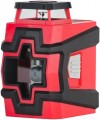Measurement range
The range at which the device remains fully operational without the use of additional receivers (see below); in other words, the radius of its action without auxiliary devices.
In some models, a range may be specified that shows the minimum (
3 cm,
5 cm) and maximum measurement ranges. But in most cases, only the maximum value is indicated.
The specific meaning of this parameter is determined by the type of instrument (see above). So, for optical levels, the measurement range is the greatest distance at which the operator can normally see the divisions of a standard leveling staff. For laser levels, this parameter determines the distance from the device to the surface on which the mark is projected, at which this projection will be easily visible to the naked eye; and in rangefinders we are talking about the greatest distance that can be measured. Typically, the measurement range is indicated for ideal conditions - in particular, in the absence of impurities in the air; in practice, it may be less due to dust, fog, or vice versa, bright sunlight "overlapping" the mark. At the same time, tools of the same type can be compared according to this characteristic.
Note that it is worth choosing a device according to the range of action, taking into account the features of the tasks that are planned to be solved with its help: after all, a large measurement range usually significa
...ntly affects the dimensions, weight, power consumption and price, but it is far from always required. For example, it hardly makes sense to look for a powerful laser level at 30-40 m if you need a device for finishing work in standard apartments.Diode emission
The wavelength of the radiation emitted by the LED of the level or rangefinder; this parameter determines primarily the colour of the laser beam. The most widespread in modern models are LEDs with a wavelength of about 635 nm — at a relatively low cost, they provide bright red radiation, giving a well-visible projection. There are also green lasers, usually at 532 nm — the marks from them are even better visible, but such LEDs are quite expensive and rarely used. And radiation with a wave longer than 780 nm belongs to the infrared spectrum. Such a laser is invisible to the naked eye and is poorly suited for leveling, but it can be used in rangefinders — of course, with a viewfinder (see "Type" for more details).
Laser colour
The color of the laser beam emitted by the device.
Red lasers are the most popular in our time: they are relatively inexpensive, while they are quite effective and functional, and also quite noticeable on most surfaces. In turn,
green lasers are better visible to the human eye (with the same emitter power); however, they are noticeably more expensive than red ones, consume more energy and have a shorter service life, and therefore are much less common.
Blue lines are rarely seen in laser instruments. Their competitive advantage over traditional green and red lasers is their high brightness, which ensures excellent visibility of the beams on many surfaces, incl. when doing outdoor work.
In some devices, you can find two types of lasers at once - both red and green. As a rule, these are levels with several projections, where green is used to build planes, and red is used for point projections.

